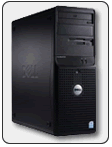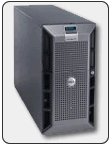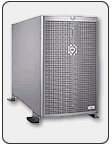SERVER
In telecommunication, the term file server has the following meanings:

SERVER
A form of disk storage that hosts files within a network; file servers do not need to be high-end but must have enough disk space to incorporate a large amount of data. Many people mistake file servers for a high-end storage system, but in reality, file servers do not need to possess great power or super fast computer specifications.
A computer program, that allows different programs, running on other computers, to access the files of that computer.
In common parlance, the term file server refers specifically to a computer on which a user can map or mount a disk drive or directory so that the directory appears to be on the machine at which the user is sitting. Additionally, on this type of file server, the user can read or write a file as though it were part of the file system of the user's computer.
Files and directories on the remote computer are usually accessed using a particular protocol, such as WebDAV, SMB, CIFS, NFS, Appletalk or their mutations.
Although files can be sent to and received from most other computers unless their primary function is access by the above means, they are generally not considered file servers as such.
Memory Requirements
 File servers have historically been instrumental in pushing up the demand for RAM. The Novell NetWare file server operating system, which dominated the market for file servers at the time of greatest growth in demand, read the entire FAT table into RAM on boot, enabling rapid access to files. Whilst this guaranteed maximum performance, it also required large quantities of memory. This in turn drove demand for Uninterruptible Power Supply (UPS) devices as it became more apparent that power outages could cause loss of data.
File servers have historically been instrumental in pushing up the demand for RAM. The Novell NetWare file server operating system, which dominated the market for file servers at the time of greatest growth in demand, read the entire FAT table into RAM on boot, enabling rapid access to files. Whilst this guaranteed maximum performance, it also required large quantities of memory. This in turn drove demand for Uninterruptible Power Supply (UPS) devices as it became more apparent that power outages could cause loss of data.
File and print
Traditionally, file and print services have been combined on the same computers due to similar computing requirements for both functions. Usually, such computers are distinct from application and database servers, which have different, usually more processor-intensive, requirements. However, as computing power increases and file serving requirements remain relatively constant, it is more common to see these functions combined on the same machine.
Security
 File servers generally offer some form of system security to limit access to files to specific users or groups. In large organizations, this is a task usually delegated to what is known as directory services such as Novell's eDirectory or Microsoft's Active Directory.
File servers generally offer some form of system security to limit access to files to specific users or groups. In large organizations, this is a task usually delegated to what is known as directory services such as Novell's eDirectory or Microsoft's Active Directory.
These servers work within the hierarchical computing environment which treat users, directories, computers, applications and files as distinct but related entities on the network and grant access based on user or group credentials. In many cases, the directory service spans many file servers, potentially hundreds for large organizations. In the past, and in smaller organizations, authentication can take place directly to the server itself.
Application server
An application server is a software engine that delivers applications to client computers or devices. Moreover, an application server should handle most, if not all, of the business logic and data access of the application. The main benefits of application server technology are ease of application development and centralization.
Although the term application server applies to all platforms, it has become heavily identified with the Sun Microsystems J2EE platform; however, it has also come to encompass servers of web-based applications, such as integrated platforms for e-commerce, content management systems, affiliate management systems and occasionally, even applied to simplistic web-site page builders. The paradigm is more similar to mainframe based applications than traditional client-server.
Common Features
 Application server products typically bundle middleware to enable applications to intercommunicate with dependent applications, like web servers, database management systems, and chart programs. Some application servers also provide an API, making them operating system independent.
Application server products typically bundle middleware to enable applications to intercommunicate with dependent applications, like web servers, database management systems, and chart programs. Some application servers also provide an API, making them operating system independent.
Portals are a very common application server mechanism by which organizations can manage information. They provide a single point of entry for all users, they can access Web services transparently from any device, and they are highly flexible. Portals can work inside or outside of the organization, and they can attach themselves to any part of it.
This term is widely used as a buzzword in the following fields:
History
In the later part of the 1990s, it was thought that a massive shift over to centrally served applications was likely, and that the desktop PC would be replaced by lightweight network computers. This would have been a return to the much older model of computing as it was done in the 1960s, with a large, very expensive central computer being accessed by multiple users using dumb terminals. The difference now was the widespread use of the graphical user interface (GUI). Certain products, such as Citrix's WinFrame, became quite popular, allowing standard Windows software to be run on an NT server, and accessed from a wide variety of clients, including non-Windows platforms such as Mac and Unix. Currently, the trend is to deliver applications via a browser (see Appaserver) or other Internet device.
Java Application Servers
Following the success of the Java platform, the term application server sometimes refers to a J2EE application server. WebLogic Server (BEA), JBoss (Red Hat), WebSphere IBM), JRun (Adobe) and Oracle OC4J (Oracle Corporation) are the better known commercial J2EE application servers. GlassFish, an open source Application Server from Sun, is the first to provide a robust, commercial, compatible Java EE 5 implementation.
The JOnAS application server, developed by the ObjectWeb consortium, is the first non-commercial, open source application server to have reached the official certification of compliance with J2EE. The programming language used is Java. The web modules are servlets and JavaServer Pages (JSP), and business logic is built into Enterprise JavaBeans (EJB). The Java 2 Platform, Enterprise Edition (J2EE) provides standards for containing the web components. Tomcat from Apache and JOnAS from ObjectWeb are typical of containers to put these modules into. Both organizations provide the code freely and openly (open source).
A JSP is a Servlet from Java that executes in a web container--the Java equivalent of CGI scripts. JSPs are a way to create HTML pages by embedding references to the server logic within the page. HTML coders and Java programmers can work side by side by referencing each other's code from within their own. JavaBeans are the independent class components of the Java2 architecture from Sun Microsystems.
Ranger Point of Sale System
Ranger POS has helped thousands of restaurants manage their store operations more effectively over the years. With over 150 installations and over 10 value added reseller around the BC, Ranger POS has both the experience and resources to handle POS automation projects of any size
© Copyright 2015 DCS TECHNOLOGIES INC.
